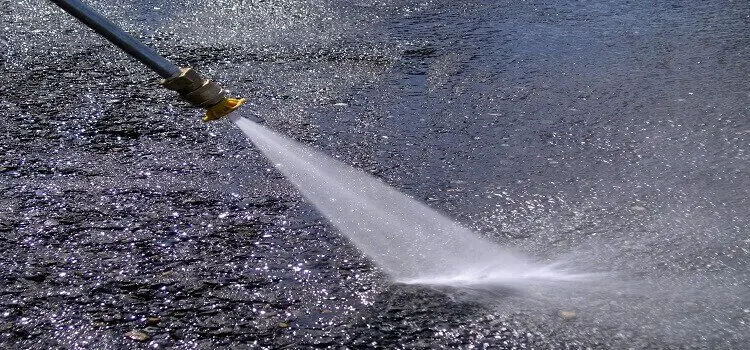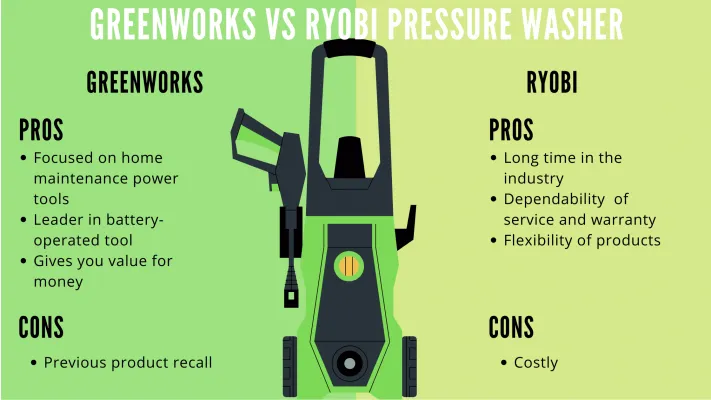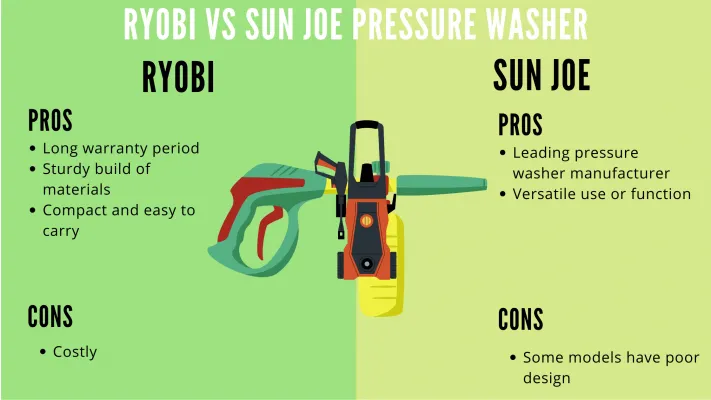Why feeling jealous about your neighbors’ new driveways when you can make your old one look similar to them if not better? Learn how to pressure wash concrete surfaces to rejuvenate your old driveways, sidewalks, or patios. Thus, let your neighbors feel jealous about your old concrete surfaces!
A pressure washer has tremendous power to wash the concrete surfaces. At the same time, this pressure can damage the concrete surface. There are a few steps you can follow to avoid such kind of unwanted incidents. In this article, we will be conveniently discussing those steps.
A small pressure washer is not bad for covering homeowners’ task. But, as far as concrete surfaces are concerned, the bigger the power washer, the easier will be the job. So, it would be wiser to use a gas pressure washer or any high-pressure washer that has rated pressure around 3000 PSI.

Well, let’s move on to the concrete pressure washing procedure. Read carefully and try to follow these steps as they are laid down.
Steps of Pressure Washing Concrete Surfaces (Driveways, Sidewalks, Patios)
Step-1: Things to Do Before Washing Concrete Surfaces
Before you start using the power giant, make sure that you are following some mandatory safety rules to avoid any incident/accident. Such as:
- Before you start the power washing, wear safety gear to protect your face, eyes, foot, and ears. A pressure washer produces a significant amount of sound that may add to irreversible hearing loss.
- Make sure that there are no kids inside the cleaning zone. Any hit from the water spike might injure the kids severely.
- Make sure to park your vehicles outside the cleaning zone to avoid any unwanted damage to the window glasses or windshield
- You need to tarp your plants so that they can be protected from the harmful impact of detergent or other cleaning chemicals
Step-2: Getting the Washer Ready for Cleaning
First of all, use a vacuum cleaner or an air blower to blow the rust and dust off the surface. You can do that manually or even you can skip the sweeping part. But, if you blow the dust, it would be easier for your power washer to make a professional look cleaning.
Now, make a visual check of your power washer for its serviceability. If the pressure washer is in working condition then attach the garden hose and the 25-degree nozzle into their respective positions.
Before you move on to start the power washer, make sure that you have purged the garden hose. Turn on the spigot that is connected to the garden hose. After that, press the wand gun for at least 30 seconds to get rid of the air inside the hose. Once you get the nice and disciplined water flow from the garden hose, move on to start the power washer.
Turn on the power washer and point the 25-degree nozzle to the points/places that are less dirty. The places/points could be Peebles, loose debris, grass, or any small tree/branches.
Step-3: Apply Detergent/Soap
Well, it is time to apply the soap/detergent to the concrete surface. It is highly recommended that you follow the recommendation of your power washer’s user manual to use the perfect detergent/soap. Using any chemical solution that the manufacturer doesn’t allow, may lead to losing the warranty claim. Furthermore, unofficial cleaning chemicals may lead to damage important parts like the power pump of the washer.
For applying soap or detergent, make sure to use the specific soap nozzle of the washer. The 25-degree spraying nozzle is not for spraying the soap. For every pressure washer, there is a dedicated soap sprayer nozzle. Make sure that your soap/detergent tank has a sufficient supply of the solution.
Step-4: Let The Detergent/Soap Do its Part
Once you have sprayed the detergent/soap to the concrete surface, the detergent starts reacting with the dirt. The detergent makes a chemical reaction with the dirt/rust to weaken its bondage with the concrete. To get the optimum result, let the detergent or soap solution to work at least for 5 minutes.
Step-5: Use a Pressure Washer Surface Cleaner
As the detergent has broken the chemical structure of the dirt, it has been easier to remove them from the concrete. Now, it is time to wash the concrete surface with a surface cleaner. Using the surface cleaner is recommended for concrete cleaning. Because the surface cleaner sprays water maintaining equal pressure on all sides (360-degrees).
There are some outstanding surface cleaners on the market. If you do not have one, consider buying a surface cleaner for getting the best result. Anyway, it is not mandatory to use the surface cleaner to clean any concrete driveways/sidewalks. But, if you skip this step and use the turbo nozzle directly, there is a risk of damaging the concrete surface.
If you are serious about cleaning concrete surfaces, you should get the best concrete brush for pressure washer, as this will help you clean in half the amount of time it usually takes.
Step-6: Use a Rotary/Turbo Nozzle for Removing Stubborn Dirt/Dust
At this phase, you will find a few points/places where stubborn specks of dirt are not willing to leave the concrete! The regular/standard nozzles and the water flow they produce are not capable of removing this culprit. So, you need to remove them using a rotary turbo nozzle. The turbo nozzle makes the cleaning more effective and time-saving. It spins the water with great power that cleans the strong dirt within seconds.
Caution! Be extra cautious while using the turbo nozzle. Do not point it towards anything that you are not trying to clean. It has immense power to break window glasses and even to kill you! Be careful sir.
Step-7: It’s time for Final Clean-up
Remove the rotary nozzle and the surface cleaner from the pressure washer. Attach the 25-degree spray nozzle one more time. Now, give a thorough clean to flush the concrete surfaces. Once you are done with the final rinsing of your concrete surface, it should look like a reborn one!
Hunter Tips: Do not forget to turn off the pressure washer after finishing off the cleaning. If the concrete surface is way bigger or the combo of several surfaces (driveways, sidewalks, patios), you need to take intervals. During the intervals, make sure that you turn off your power washer too. The washer needs to cool down and rest itself to save the power pump.
FAQs Related to Pressure Washing of Concrete Surfaces
Q1. Is Pressure Washing Bad for Concrete?
Answer: The answer could be both yes and no at the same time. If you do not follow the SOP (Standard Operating Procedure) to pressure wash your concrete surface, you could end up damaging the concrete. On the other hand, if you follow the process, there is no single scope to harm your concrete. So, you need to be watchful during the pressure washer.
Q2. What Do You put on Concrete Before Pressure Washing?
Answer: Nothing! Just apply the detergent/soap on the concrete and wait for 5-10 minutes. During this time the detergent will break down the chemical structure of the dirt. After that, clean with freshwater spray. That’s it!
Q3.What is the Best Way to Clean Concrete?
Answer: The best approach to cleaning is the same as we discussed above. One more thing you can do is making the cleaning chemical solution on your own. To do that, mix around 1/2 cup of baking soda to 1 gallon of water. After that, add 1/8 cup of liquid dish detergent with the mix to get a gentle cleaning solution. Fortunately, some companies are already producing this sort of cleaning solution.
Pressure Washing Concrete Surfaces
Conclusion
The washing process of any concrete surface be it driveways, sidewalks, or patios is more or less the same. You may follow any unique pattern but the basic is always the same. In any way, you don’t have an option to gamble with the safety precautions. Try to use the perfect hoses/nozzles for specific jobs. That will increase your cleaning efficiency and save your valuable time. We hope that our coverage on “how to pressure wash concrete surfaces” was a bit helpful. For any queries, feel free to drop a line.


